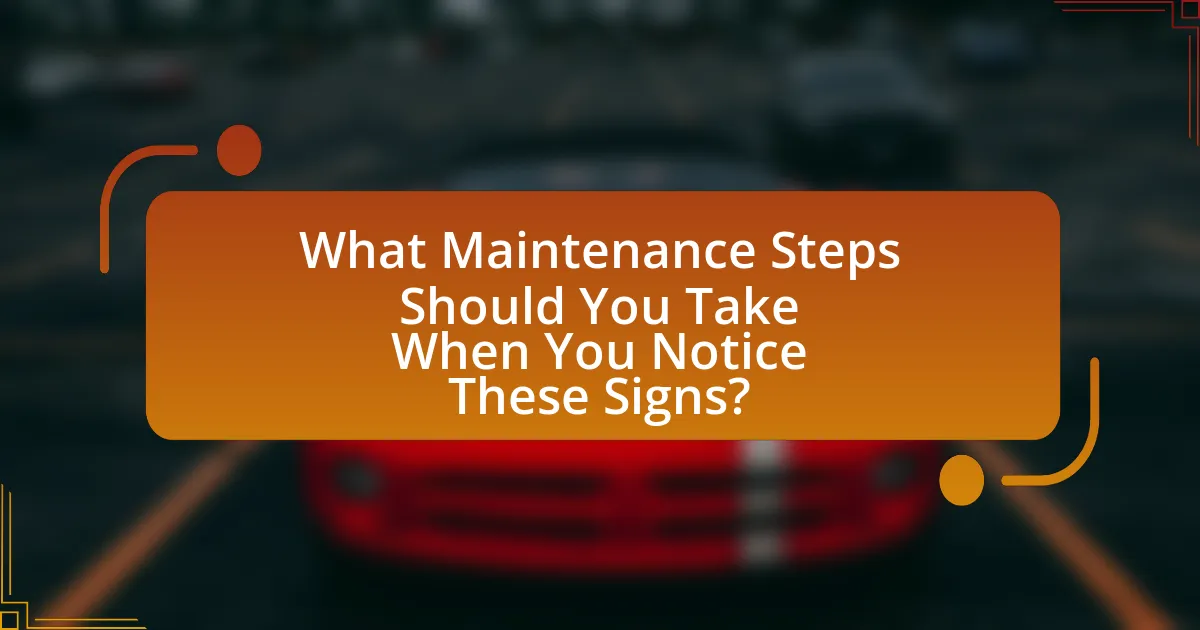The article focuses on the top five signs indicating that a car requires a tune-up: poor fuel efficiency, rough idling, difficulty starting, decreased acceleration, and illuminated warning lights. It emphasizes the importance of recognizing these symptoms early to maintain vehicle performance and safety, as neglecting them can lead to more severe issues and costly repairs. Additionally, the article outlines how to identify maintenance needs, the specific symptoms related to different vehicle types, and the potential consequences of ignoring these signs. It also provides practical advice on performing basic vehicle inspections and scheduling regular tune-ups to enhance overall vehicle performance and longevity.

What are the Top 5 Signs Your Car Needs a Tune-Up?
The top five signs your car needs a tune-up are poor fuel efficiency, rough idling, difficulty starting, decreased acceleration, and illuminated warning lights. Poor fuel efficiency indicates that the engine is not running optimally, often due to worn spark plugs or dirty air filters. Rough idling suggests that the engine is misfiring, which can be caused by issues with ignition components. Difficulty starting can point to problems with the battery, starter, or fuel system. Decreased acceleration may result from a clogged fuel filter or failing sensors. Finally, illuminated warning lights on the dashboard signal that the vehicle’s onboard diagnostics have detected a problem that requires attention. Regular maintenance can prevent these issues and ensure the vehicle operates efficiently.
How can you identify when your car requires maintenance?
You can identify when your car requires maintenance by observing specific signs such as unusual noises, warning lights on the dashboard, changes in performance, fluid leaks, and irregular tire wear. Unusual noises, like grinding or squeaking, often indicate issues with brakes or other components. Warning lights, such as the check engine light, signal that the vehicle’s onboard diagnostics have detected a problem. Changes in performance, such as decreased acceleration or poor fuel efficiency, suggest that the engine or transmission may need attention. Fluid leaks under the car can indicate problems with the engine, transmission, or cooling system. Lastly, irregular tire wear can point to alignment or suspension issues. Regularly monitoring these signs can help ensure timely maintenance and prevent more significant problems.
What specific symptoms indicate a need for a tune-up?
Specific symptoms indicating a need for a tune-up include decreased fuel efficiency, rough idling, difficulty starting the engine, poor acceleration, and the illumination of the check engine light. Decreased fuel efficiency occurs when the engine is not operating optimally, often due to worn spark plugs or dirty air filters. Rough idling can signal issues with the ignition system or fuel delivery. Difficulty starting the engine may indicate battery problems or fuel system malfunctions. Poor acceleration often results from engine misfires or clogged fuel injectors. The check engine light serves as a warning that the vehicle’s onboard diagnostics have detected an issue requiring attention.
How do these symptoms vary by vehicle type?
Symptoms of a vehicle needing a tune-up vary by vehicle type, primarily due to differences in engine design, fuel system, and electronic controls. For example, gasoline engines may exhibit rough idling or decreased fuel efficiency, while diesel engines often show signs of excessive exhaust smoke or difficulty starting. Additionally, hybrid vehicles may display warning lights related to battery performance or regenerative braking issues. These variations are influenced by the specific mechanical and electronic systems unique to each vehicle type, which dictate how symptoms manifest when maintenance is required.
Why is it important to recognize these signs early?
Recognizing the signs that indicate a car needs a tune-up early is crucial for maintaining vehicle performance and safety. Early detection of issues such as poor fuel efficiency, unusual noises, or warning lights can prevent more severe problems, which often lead to costly repairs or breakdowns. For instance, according to the American Automobile Association (AAA), regular maintenance can improve fuel economy by up to 10%, highlighting the financial benefits of timely interventions. Additionally, addressing these signs promptly can enhance the vehicle’s lifespan and ensure safer driving conditions, as neglected issues may compromise critical systems like brakes or steering.
What are the potential consequences of ignoring tune-up signs?
Ignoring tune-up signs can lead to decreased vehicle performance and increased repair costs. When a car shows signs that it needs a tune-up, such as poor fuel efficiency, rough idling, or difficulty starting, neglecting these indicators can result in more severe engine issues over time. For instance, failing to address a misfiring engine can lead to damage to the catalytic converter, which can cost upwards of $1,000 to replace. Additionally, ignoring these signs can compromise safety, as worn-out components may lead to brake failure or steering issues. Regular maintenance, including tune-ups, is essential for prolonging the lifespan of the vehicle and ensuring safe operation.
How can timely tune-ups improve vehicle performance?
Timely tune-ups can significantly enhance vehicle performance by ensuring that all engine components function optimally. Regular maintenance, such as replacing spark plugs, air filters, and fuel filters, leads to improved fuel efficiency, increased horsepower, and reduced emissions. For instance, a study by the U.S. Department of Energy indicates that a well-tuned engine can improve fuel economy by an average of 4% and up to 40% in some cases. This optimization not only extends the lifespan of the vehicle but also contributes to a smoother driving experience.

What are the Common Symptoms Indicating a Tune-Up is Needed?
Common symptoms indicating a tune-up is needed include decreased fuel efficiency, rough idling, difficulty starting the engine, poor acceleration, and the illumination of the check engine light. Decreased fuel efficiency often results from worn spark plugs or dirty air filters, which can lead to higher fuel consumption. Rough idling can indicate issues with the ignition system or fuel delivery. Difficulty starting the engine may stem from a failing battery or spark plugs. Poor acceleration is frequently linked to problems in the fuel system or ignition components. Lastly, the check engine light can signal various underlying issues that require diagnostic attention.
What does poor fuel efficiency indicate?
Poor fuel efficiency indicates that a vehicle is not operating optimally, often due to issues such as engine problems, clogged fuel injectors, or tire pressure discrepancies. These factors can lead to increased fuel consumption, suggesting that the car may require maintenance or a tune-up to restore its efficiency. For instance, a study by the U.S. Department of Energy shows that maintaining proper tire pressure can improve fuel economy by up to 3%.
How can you measure changes in fuel efficiency?
To measure changes in fuel efficiency, one can calculate the miles per gallon (MPG) by dividing the total miles driven by the gallons of fuel consumed during that distance. This method provides a clear numerical value that reflects fuel efficiency. For instance, if a vehicle travels 300 miles and consumes 10 gallons of fuel, the fuel efficiency is 30 MPG. Tracking this value over time allows for the identification of trends or changes in fuel efficiency, which can indicate the need for maintenance or a tune-up. Regular monitoring of fuel efficiency can reveal significant deviations, such as a decrease in MPG, which may suggest issues like engine problems or fuel system inefficiencies.
What factors contribute to decreased fuel efficiency?
Decreased fuel efficiency is primarily caused by factors such as poor engine performance, improper tire pressure, and dirty air filters. Poor engine performance can stem from issues like worn spark plugs or fuel injectors, which can lead to incomplete combustion and increased fuel consumption. Improper tire pressure affects rolling resistance; under-inflated tires can decrease fuel efficiency by up to 3% for every 1 psi drop in pressure. Additionally, dirty air filters restrict airflow to the engine, causing it to work harder and consume more fuel. These factors collectively contribute to a significant reduction in a vehicle’s fuel efficiency.
How does engine performance relate to tune-up needs?
Engine performance directly influences tune-up needs, as a decline in performance often indicates that maintenance is required. When an engine experiences issues such as reduced power, poor fuel efficiency, or rough idling, these symptoms suggest that components like spark plugs, filters, or fuel injectors may need servicing or replacement. Regular tune-ups can restore optimal engine performance by addressing these issues, ensuring that the vehicle operates efficiently and reliably. For instance, studies show that replacing worn spark plugs can improve fuel economy by up to 30%, highlighting the importance of timely tune-ups in maintaining engine performance.
What are the signs of engine misfiring or rough idling?
The signs of engine misfiring or rough idling include a noticeable shaking or vibration of the vehicle, irregular engine noise, a decrease in power during acceleration, and the illumination of the check engine light. These symptoms indicate that the engine is not firing on all cylinders, which can be caused by issues such as faulty spark plugs, ignition coils, or fuel injectors. For instance, a study by the Automotive Service Association highlights that misfiring can lead to increased emissions and reduced fuel efficiency, confirming the importance of addressing these signs promptly.
How can engine performance issues affect overall driving experience?
Engine performance issues can significantly diminish the overall driving experience by causing reduced power, poor fuel efficiency, and increased emissions. When an engine struggles to perform optimally, drivers may notice sluggish acceleration, which can lead to frustration and safety concerns during overtaking or merging. Additionally, compromised engine performance often results in higher fuel consumption, leading to increased costs and more frequent refueling. According to the U.S. Department of Energy, a well-tuned engine can improve fuel efficiency by up to 4%, highlighting the economic impact of engine issues. Furthermore, persistent performance problems can trigger warning lights on the dashboard, creating anxiety for drivers regarding vehicle reliability. Overall, these factors contribute to a less enjoyable and potentially unsafe driving experience.

What Maintenance Steps Should You Take When You Notice These Signs?
When you notice signs that your car needs a tune-up, you should first conduct a thorough inspection of the vehicle. This includes checking the engine oil level, inspecting the air filter, and examining the spark plugs for wear. Regularly changing the engine oil, typically every 5,000 to 7,500 miles, ensures optimal engine performance and longevity. Additionally, replacing the air filter every 15,000 to 30,000 miles can improve fuel efficiency and engine performance. Spark plugs should be replaced every 30,000 to 100,000 miles, depending on the type, to maintain proper ignition and engine function. These maintenance steps are essential for preventing more significant issues and ensuring the vehicle operates efficiently.
How can you perform a basic self-check on your vehicle?
To perform a basic self-check on your vehicle, inspect the following key components: check the oil level, examine tire pressure and tread, test the battery condition, inspect fluid levels (coolant, brake, and windshield washer), and ensure all lights are functioning. Regularly checking these elements helps identify potential issues early, which can prevent more significant problems and costly repairs. For instance, maintaining proper tire pressure can improve fuel efficiency by up to 3%, according to the U.S. Department of Energy.
What tools do you need for a basic vehicle inspection?
For a basic vehicle inspection, you need a tire pressure gauge, an OBD-II scanner, a flashlight, a multimeter, and basic hand tools like wrenches and screwdrivers. These tools allow you to check tire pressure, diagnose engine issues, inspect electrical systems, and perform minor repairs. The tire pressure gauge ensures tires are inflated to the manufacturer’s specifications, which is crucial for safety and fuel efficiency. An OBD-II scanner reads diagnostic trouble codes, helping identify engine problems. A flashlight aids in inspecting hard-to-see areas, while a multimeter measures electrical voltage and continuity. Basic hand tools are essential for tightening or replacing components during the inspection process.
What specific areas should you focus on during your inspection?
During your inspection, you should focus on the engine performance, fluid levels, battery condition, tire health, and brake functionality. Engine performance can be assessed by checking for unusual noises or vibrations, which may indicate issues. Fluid levels, including oil, coolant, and transmission fluid, should be checked to ensure they are at appropriate levels to prevent overheating or mechanical failure. The battery condition can be evaluated by inspecting for corrosion and testing the charge, as a weak battery can lead to starting problems. Tire health involves checking tread depth and pressure, as worn or improperly inflated tires can affect handling and safety. Finally, brake functionality should be assessed by testing the responsiveness and listening for any grinding noises, which can indicate wear or failure. These areas are critical for maintaining vehicle safety and performance.
What are the best practices for scheduling a tune-up?
The best practices for scheduling a tune-up include checking the vehicle’s owner manual for recommended intervals, monitoring the car’s performance for signs of issues, and choosing a reputable mechanic. Following the owner’s manual ensures that the tune-up aligns with manufacturer specifications, which typically suggest intervals based on mileage or time. Observing performance indicators, such as decreased fuel efficiency or unusual noises, can signal the need for a tune-up. Selecting a qualified mechanic with positive reviews and certifications guarantees that the service will be performed correctly, enhancing the vehicle’s longevity and performance.
How often should you schedule tune-ups based on mileage?
Schedule tune-ups every 30,000 miles for optimal vehicle performance. This recommendation is based on manufacturer guidelines and industry standards, which suggest that regular maintenance at this interval helps ensure engine efficiency and longevity. Additionally, some vehicles may require tune-ups more frequently, such as every 15,000 miles, depending on driving conditions and specific manufacturer recommendations. Regularly adhering to these mileage benchmarks can prevent potential issues and maintain the vehicle’s overall health.
What should you discuss with your mechanic during a tune-up appointment?
During a tune-up appointment, you should discuss the specific symptoms your vehicle is experiencing, such as poor fuel efficiency, rough idling, or difficulty starting. These symptoms help the mechanic identify potential issues with components like spark plugs, air filters, and fuel injectors. Additionally, you should inquire about the recommended maintenance schedule for your vehicle, including when to replace parts based on mileage or time intervals. Discussing any recent changes in performance or unusual noises can also provide valuable context for the mechanic. This focused dialogue ensures that the tune-up addresses both immediate concerns and long-term vehicle health.
What are some tips for maintaining your vehicle to prevent tune-up needs?
Regular maintenance of your vehicle can significantly reduce the need for tune-ups. Key tips include changing the oil every 3,000 to 5,000 miles to ensure engine lubrication and performance, checking and replacing air filters to maintain optimal airflow and fuel efficiency, and inspecting spark plugs for wear, as they are crucial for ignition. Additionally, keeping tires properly inflated and rotated can enhance handling and fuel economy, while monitoring fluid levels—such as coolant, brake fluid, and transmission fluid—ensures all systems operate smoothly. Following these practices can extend the life of your vehicle and minimize the frequency of tune-ups.


